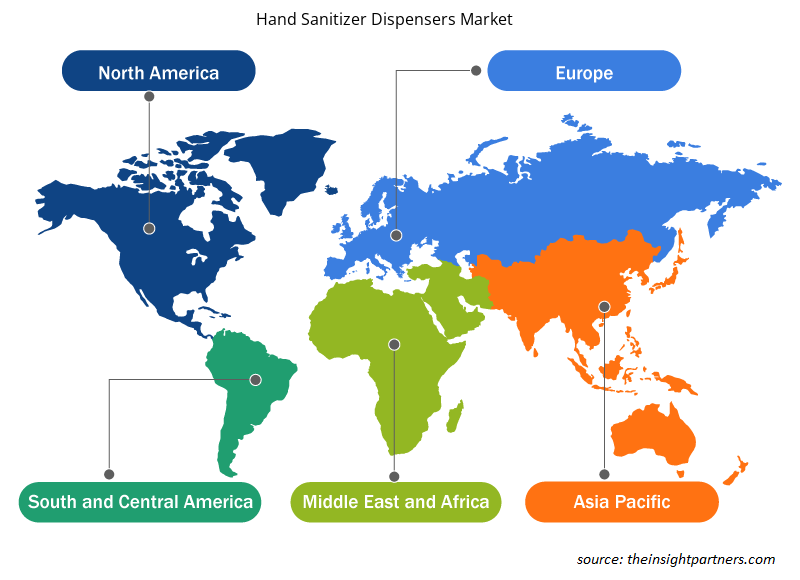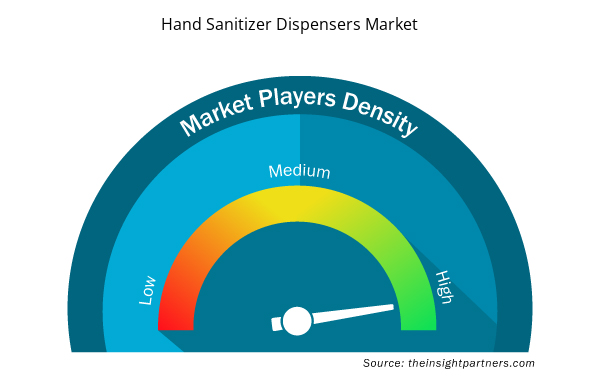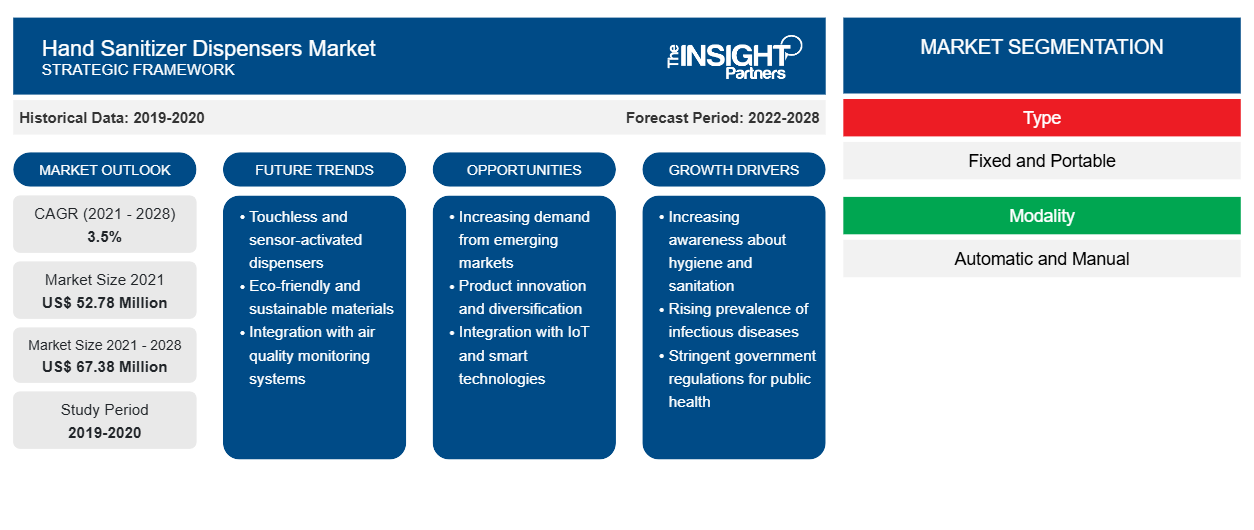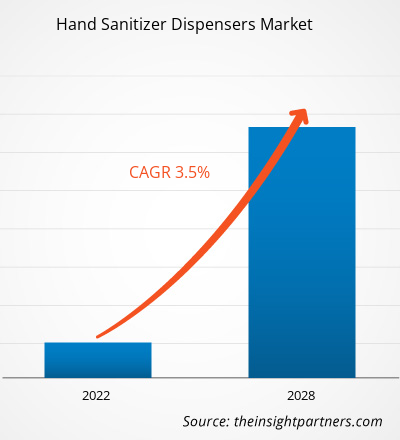洗手液分配器市场预计将从 2021 年的 5278 万美元增长到 2028 年的 6738 万美元;预计2021 年至 2028 年的复合年增长率为 3.5%。
洗手液分配器是分配液体、凝胶或喷雾形式的洗手液的装置。由于 COVID-19 大流行而导致的健康问题日益严重,这是推动全球洗手液分配器市场增长的主要决定因素之一。此外,政府实施有关公共场所洗手液的法规也推动了市场的增长。洗手液分配器需求的突然激增导致众多新市场参与者的进入。
预计亚太地区的洗手液分配器市场在预测期内将以最高的复合年增长率增长。COVID-19 的爆发导致洗手液销量急剧上升。人们采取了各种预防措施,例如戴口罩、使用洗手液和服用增强免疫力的补充剂,以防止自己感染。随着该地区各国政府放松某些封锁限制,各种商店和办公室开始营业,从而大大增加了对洗手液分配器的需求。许多小企业主和许多本地和小规模制造商利用这种需求,开始制造适用于零售商店、公共卫生间、办公室、机场、火车站、医院、剧院和其他公共场所的自动和手动洗手液分配器。
定制此报告以满足您的需求
您可以免费定制任何报告,包括本报告的部分内容、国家级分析、Excel 数据包,以及为初创企业和大学提供优惠和折扣
- 获取此报告的关键市场趋势。这个免费样品将包括数据分析,从市场趋势到估计和预测。
COVID-19 疫情对洗手液分配器市场的影响
持续的疫情有利于洗手液分配器行业的发展,因为人们越来越关注手部卫生和环境卫生,同时在办公室和工作场所、医院、学校、商场、机场、火车站等公共场所安装的消毒站也越来越多。此外,洗手液需求的迅猛增长也促进了洗手液分配器的增长。Gojo Industries Inc.扩大了生产线并重组了供应链,预计洗手液需求将比疫情前激增。Gojo Industries Inc.旗下的洗手液品牌Purell声称,消费者对手部卫生的关注预计将持续到疫情后。因此,随着洗手液需求的增加,消毒分配器的需求预计也会增加。例如,根据 GP PRO 进行的调查,公共场所对非接触式消毒剂分配器的需求将增加。调查还显示,约 85% 的买家计划使用消毒剂装置。目前,许多人在家中使用洗手液分配器以增加安全性。此外,随着各经济体计划恢复运营,全球对洗手液分配器的需求预计将上升。人们对健康和卫生的日益关注,加上洗手液需求的不断增长,以及知名制造商对先进产品的大量投资,预计将推动洗手液分配器市场在当前疫情期间以及疫情后时期的增长。
市场洞察
产品创新
随着洗手液分配器研发活动的大量投入,新产品创新不断涌现,并应用于各个领域。例如,对经济运营的日益关注导致了低成本洗手液分配器的开发。多项研究表明,在洗手液分配器的生产中使用低成本组件。例如,2020 年 3 月,印度初创公司 Alphavogue 开始制造自动洗手液分配器,这种分配器可以轻松安装在墙上或放在桌子上。这种分配器由 3 毫米厚的丙烯酸板制成,可以借助热量弯曲。此外,这种分配系统可用于多种工业和商业应用,旨在在未来逐步淘汰对电池供电型分配器的需求。
基于类型的洞察
根据类型,洗手液分配器市场分为固定式和便携式。固定式部分在 2020 年占据了更大的市场份额。固定式洗手液分配器适合任何位置,因为它占用空间小且安装简单。许多制造商正在推出价格实惠的壁挂式洗手液分配器,适用于餐厅、公共卫生间、学校、办公室等公共场所,以满足广泛的客户群并满足消费者的不同需求。
基于模态的洞察
根据方式,洗手液分配器市场分为自动和手动。自动部分在 2020 年占据了较大的市场份额。自动部分在 2020 年占据了市场主导地位,预计在整个预测期内将保持主导地位。自动洗手液分配器是一种分配可控量消毒剂的设备。在公共卫生间,它们经常与自动水龙头一起使用。它们控制消毒剂的用量,同时防止传染病的传播。由于自动洗手液分配器具有免接触式高安全性,COVID-19 疫情的爆发大大增加了对自动洗手液分配器的需求。
洗手液分配器市场的一些参与者包括 Umbra;Toshi Automatic Systems Pvt Ltd;深圳市 SVAVO 智能科技有限公司;Kingsway Technology;Hokwang Industries Co., Ltd.;Dihour;GOJO Industries, Inc.;Essity AB;Bright Pancar Sdn Bhd;和 American Specialties, Inc. 主要公司正在采用并购和研发等战略来扩大客户群并在全球市场上获得显著份额,这也使他们能够在全球范围内保持自己的品牌名称。
洗手液分配器市场区域洞察
Insight Partners 的分析师已详尽解释了预测期内影响洗手液分配器市场的区域趋势和因素。本节还讨论了洗手液分配器市场在北美、欧洲、亚太地区、中东和非洲以及南美和中美洲的细分市场和地理位置。

- 获取洗手液分配器市场的区域特定数据
洗手液分配器市场报告范围
| 报告属性 | 细节 |
|---|---|
| 2021 年市场规模 | 5278万美元 |
| 2028 年市场规模 | 6,738万美元 |
| 全球复合年增长率(2021 - 2028) | 3.5% |
| 史料 | 2019-2020 |
| 预测期 | 2022-2028 |
| 涵盖的领域 | 按类型
|
| 覆盖地区和国家 | 北美
|
| 市场领导者和主要公司简介 |
|
洗手液分配器市场参与者密度:了解其对业务动态的影响
洗手液分配器市场正在快速增长,这得益于终端用户需求的不断增长,这些需求源于消费者偏好的不断变化、技术进步以及对产品优势的认识不断提高等因素。随着需求的增加,企业正在扩大其产品范围,进行创新以满足消费者的需求,并利用新兴趋势,从而进一步推动市场增长。
市场参与者密度是指在特定市场或行业内运营的企业或公司的分布情况。它表明在给定市场空间中,相对于其规模或总市场价值,有多少竞争对手(市场参与者)存在。
在洗手液分配器市场运营的主要公司有:
- 本影
- 东芝自动系统私人有限公司
- 深圳市斯威沃智能科技有限公司
- 金斯威科技
- 浩光工业公司
免责声明:上面列出的公司没有按照任何特定顺序排列。

- 获取洗手液分配器市场顶级关键参与者概述
报告亮点
- 洗手液分配器市场的渐进式行业趋势可帮助参与者制定有效的长期战略
- 发达市场和发展中市场采用的业务增长战略
- 2019 年至 2028 年洗手液分配器产品市场的定量分析
- 洗手液分配器产品全球需求量估计
- 波特五力分析说明市场竞争力
- 了解竞争市场状况的最新发展
- 市场趋势和前景以及推动和抑制洗手液分配器产品市场增长的因素
- 通过强调支撑商业利益的市场策略来协助决策过程,从而促进市场增长
- 洗手液分配器产品各节点市场规模
- 市场的详细概述和细分,以及洗手液分配器产品行业动态
- 各地区洗手液分配器市场规模及增长机会
洗手液分配器市场 – 按类型
- 固定的
- 便携的
洗手液分配器市场 – 按方式
- 自动的
- 手动的
公司简介
- 本影
- 东芝自动系统私人有限公司
- 深圳市斯威沃智能科技有限公司
- 金斯威科技
- 浩光工业公司
- 迪霍爾
- GOJO 工业公司
- 埃西蒂公司
- Bright Pancar 有限公司
- 美国特产有限公司
- 历史分析(2 年)、基准年、预测(7 年)及复合年增长率
- PEST 和 SWOT 分析
- 市场规模价值/数量 - 全球、区域、国家
- 行业和竞争格局
- Excel 数据集



Report Coverage
Revenue forecast, Company Analysis, Industry landscape, Growth factors, and Trends

Segment Covered
This text is related
to segments covered.

Regional Scope
North America, Europe, Asia Pacific, Middle East & Africa, South & Central America

Country Scope
This text is related
to country scope.
常见问题
Among the segments of type, fixed segment led the market in 2020. A fixed hand sanitizer dispenser is ideal for any location because it takes up little space and is simple to install. Many manufacturers are launching affordable wall-mounted hand sanitizer dispensers suitable for public places such as restaurants, public washrooms, schools, offices, and others to cater to wide customer base and meet different requirements of consumers.
The major players operating in the global hand sanitizer dispensers market are Umbra; Toshi Automatic Systems Pvt Ltd; SHENZHEN SVAVO INTELLIGENT TECHNOLOGY CO., LTD; Kingsway Technology; Hokwang Industries Co., Ltd.; Dihour; GOJO Industries, Inc.; Essity AB; Bright Pancar Sdn Bhd; and American Specialties, Inc., and many others.
In 2020, the hand sanitizer dispensers market was predominant by Europe at the global level. The European government and regulatory bodies have adopted a number of preventive measures such as promoting good hygiene habits, usage of hand sanitizers, and installation of sanitizer dispensers at public places, and many others. As a result, the European hand sanitizer dispenser market is likely to benefit from increased government efforts to combat the spread of the COVID-19 virus.
Trends and growth analysis reports related to Consumer Goods : READ MORE..
The List of Companies - Hand Sanitizer Dispensers Market
- Umbra
- Toshi Automatic Systems Pvt Ltd
- SHENZHEN SVAVO INTELLIGENT TECHNOLOGY CO., LTD
- Kingsway Technology
- Hokwang Industries Co., Ltd.
- Dihour
- GOJO Industries, Inc.
- Essity AB
- Bright Pancar Sdn Bhd
- American Specialties, Inc.
The Insight Partners performs research in 4 major stages: Data Collection & Secondary Research, Primary Research, Data Analysis and Data Triangulation & Final Review.
- Data Collection and Secondary Research:
As a market research and consulting firm operating from a decade, we have published and advised several client across the globe. First step for any study will start with an assessment of currently available data and insights from existing reports. Further, historical and current market information is collected from Investor Presentations, Annual Reports, SEC Filings, etc., and other information related to company’s performance and market positioning are gathered from Paid Databases (Factiva, Hoovers, and Reuters) and various other publications available in public domain.
Several associations trade associates, technical forums, institutes, societies and organization are accessed to gain technical as well as market related insights through their publications such as research papers, blogs and press releases related to the studies are referred to get cues about the market. Further, white papers, journals, magazines, and other news articles published in last 3 years are scrutinized and analyzed to understand the current market trends.
- Primary Research:
The primarily interview analysis comprise of data obtained from industry participants interview and answers to survey questions gathered by in-house primary team.
For primary research, interviews are conducted with industry experts/CEOs/Marketing Managers/VPs/Subject Matter Experts from both demand and supply side to get a 360-degree view of the market. The primary team conducts several interviews based on the complexity of the markets to understand the various market trends and dynamics which makes research more credible and precise.
A typical research interview fulfils the following functions:
- Provides first-hand information on the market size, market trends, growth trends, competitive landscape, and outlook
- Validates and strengthens in-house secondary research findings
- Develops the analysis team’s expertise and market understanding
Primary research involves email interactions and telephone interviews for each market, category, segment, and sub-segment across geographies. The participants who typically take part in such a process include, but are not limited to:
- Industry participants: VPs, business development managers, market intelligence managers and national sales managers
- Outside experts: Valuation experts, research analysts and key opinion leaders specializing in the electronics and semiconductor industry.
Below is the breakup of our primary respondents by company, designation, and region:

Once we receive the confirmation from primary research sources or primary respondents, we finalize the base year market estimation and forecast the data as per the macroeconomic and microeconomic factors assessed during data collection.
- Data Analysis:
Once data is validated through both secondary as well as primary respondents, we finalize the market estimations by hypothesis formulation and factor analysis at regional and country level.
- Macro-Economic Factor Analysis:
We analyse macroeconomic indicators such the gross domestic product (GDP), increase in the demand for goods and services across industries, technological advancement, regional economic growth, governmental policies, the influence of COVID-19, PEST analysis, and other aspects. This analysis aids in setting benchmarks for various nations/regions and approximating market splits. Additionally, the general trend of the aforementioned components aid in determining the market's development possibilities.
- Country Level Data:
Various factors that are especially aligned to the country are taken into account to determine the market size for a certain area and country, including the presence of vendors, such as headquarters and offices, the country's GDP, demand patterns, and industry growth. To comprehend the market dynamics for the nation, a number of growth variables, inhibitors, application areas, and current market trends are researched. The aforementioned elements aid in determining the country's overall market's growth potential.
- Company Profile:
The “Table of Contents” is formulated by listing and analyzing more than 25 - 30 companies operating in the market ecosystem across geographies. However, we profile only 10 companies as a standard practice in our syndicate reports. These 10 companies comprise leading, emerging, and regional players. Nonetheless, our analysis is not restricted to the 10 listed companies, we also analyze other companies present in the market to develop a holistic view and understand the prevailing trends. The “Company Profiles” section in the report covers key facts, business description, products & services, financial information, SWOT analysis, and key developments. The financial information presented is extracted from the annual reports and official documents of the publicly listed companies. Upon collecting the information for the sections of respective companies, we verify them via various primary sources and then compile the data in respective company profiles. The company level information helps us in deriving the base number as well as in forecasting the market size.
- Developing Base Number:
Aggregation of sales statistics (2020-2022) and macro-economic factor, and other secondary and primary research insights are utilized to arrive at base number and related market shares for 2022. The data gaps are identified in this step and relevant market data is analyzed, collected from paid primary interviews or databases. On finalizing the base year market size, forecasts are developed on the basis of macro-economic, industry and market growth factors and company level analysis.
- Data Triangulation and Final Review:
The market findings and base year market size calculations are validated from supply as well as demand side. Demand side validations are based on macro-economic factor analysis and benchmarks for respective regions and countries. In case of supply side validations, revenues of major companies are estimated (in case not available) based on industry benchmark, approximate number of employees, product portfolio, and primary interviews revenues are gathered. Further revenue from target product/service segment is assessed to avoid overshooting of market statistics. In case of heavy deviations between supply and demand side values, all thes steps are repeated to achieve synchronization.
We follow an iterative model, wherein we share our research findings with Subject Matter Experts (SME’s) and Key Opinion Leaders (KOLs) until consensus view of the market is not formulated – this model negates any drastic deviation in the opinions of experts. Only validated and universally acceptable research findings are quoted in our reports.
We have important check points that we use to validate our research findings – which we call – data triangulation, where we validate the information, we generate from secondary sources with primary interviews and then we re-validate with our internal data bases and Subject matter experts. This comprehensive model enables us to deliver high quality, reliable data in shortest possible time.


 获取此报告的免费样本
获取此报告的免费样本